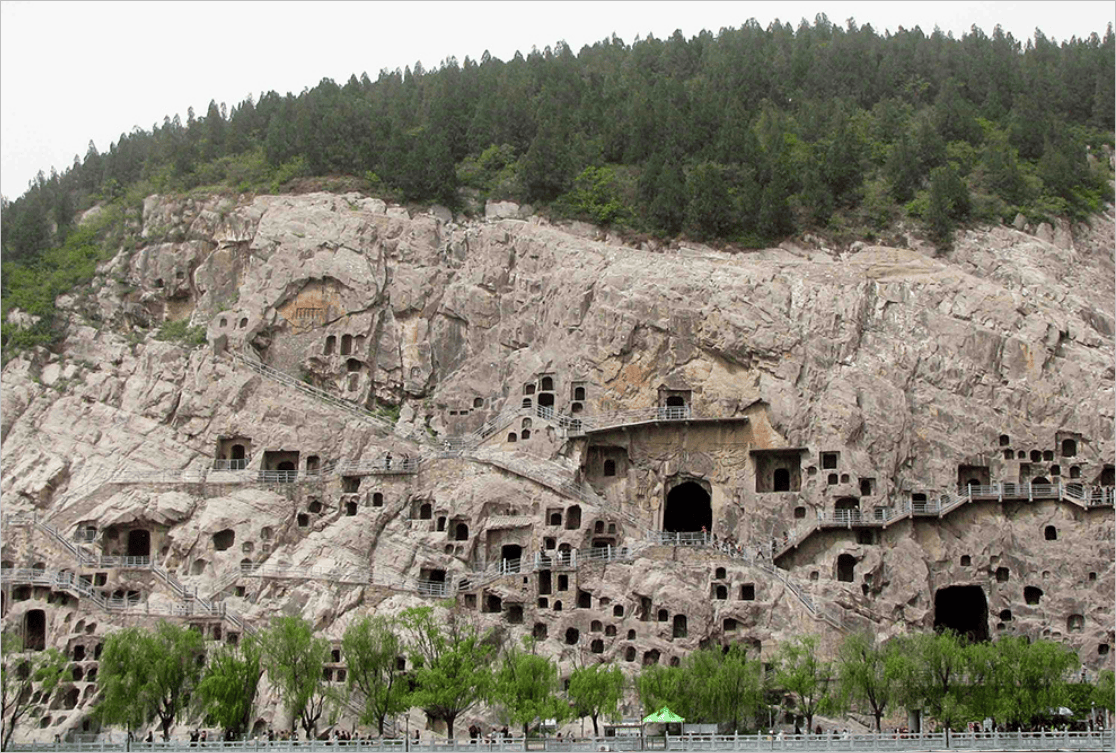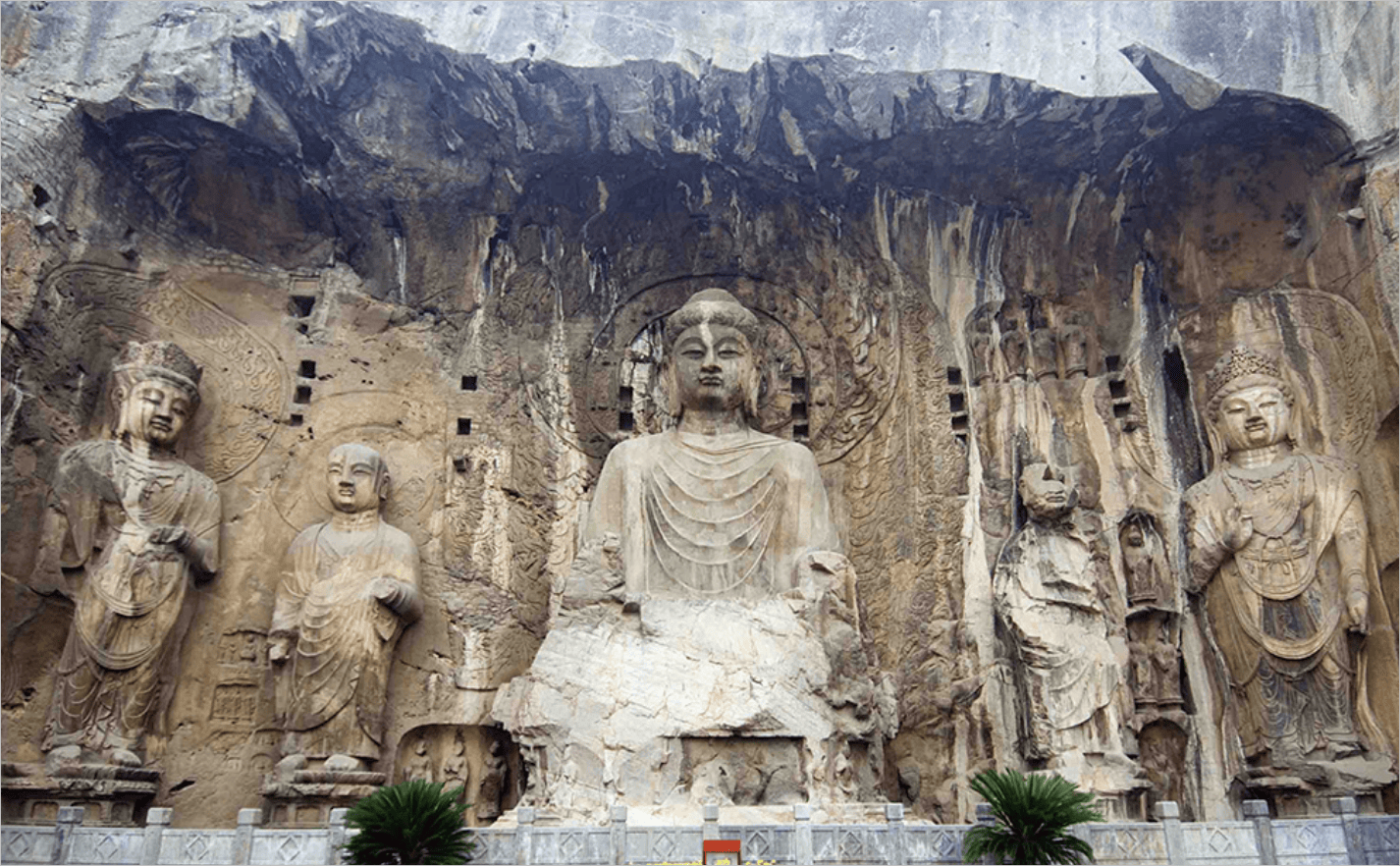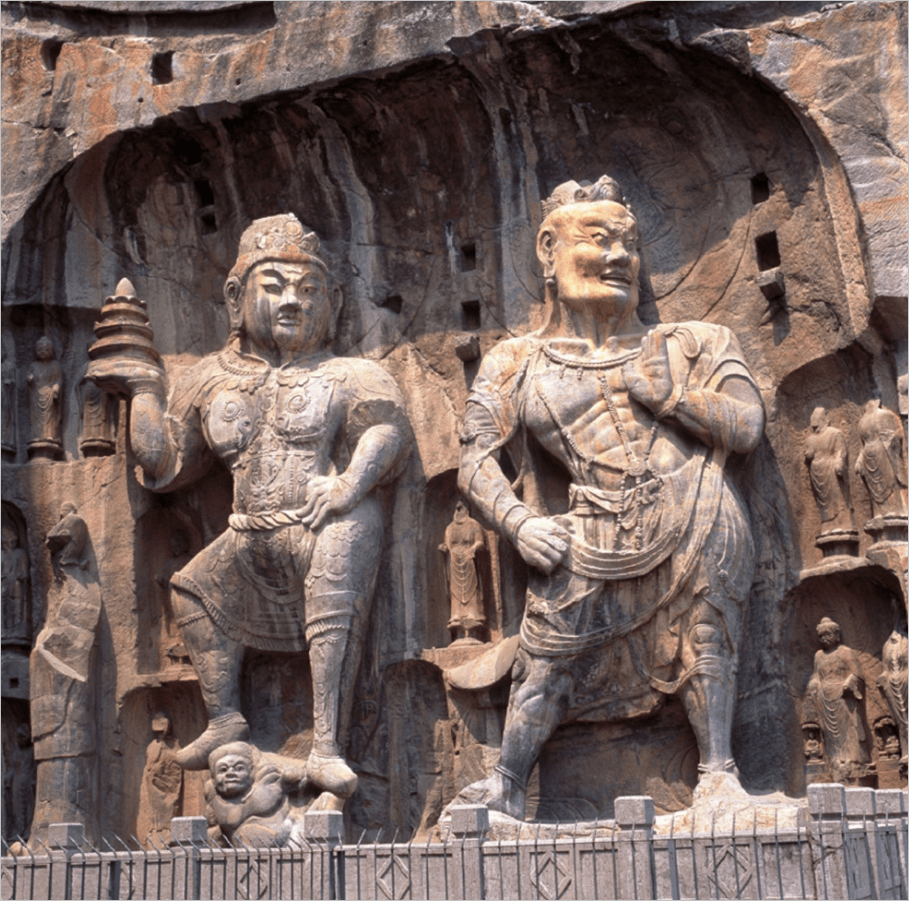
Luoyang, known as the “ancient capital of nine dynasties”, was actually the capital of thirteen dynasties in succession. When it comes to Luoyang, the most well-known attractions are the Longmen Grottoes. Its rich and profound cultural connotation and beautiful landscape scenery leave a beautiful and deep impression on people.
Longmen, 13 kilometers from downtown, is the natural gateway to the south of Luoyang, where the Xiang Mountain and Longmen Mountain stand opposite to each other on both sides of the river, and the water in the Yi River flows, looking like a natural gate, which is called “Yi Que” in ancient times. It was named “Dragon Gate” because the palace gates were facing Yi Que, and the ancient emperor was known as the true son of the dragon. The world-famous Longmen Grottoes are carved into the cliffs on both sides of the Yi River and are about 1 kilometer long from north to south. From the Northern Wei Emperor Xiaowen moved the capital to Luoyang when the construction began, through the Eastern Wei, Western Wei, Northern Qi, Sui, Tang, extended to the Northern Song Dynasty, the cumulative large-scale excavation of more than 400 years, the existing caves 2345 niches, more than 2800 inscriptions, more than 70 pagodas, nearly 110,000 statues. The number of niches, statues and inscriptions ranks among the top of China’s grottoes, with Dunhuang Mogao Caves, Datong Yungang Grottoes and known as China’s three major Buddhist art treasures.
Accompanied by green mountains and green water, the Longmen Grottoes, with its ten thousand images, were announced by the State Council as the first batch of national key cultural relics protection units as early as 1961, the first batch of national scenic spots by the State Council in 1982, and the Longmen Grottoes were inscribed on the World Cultural Heritage List by UNESCO in November 2000.

The great statue of Luciana in Fengxian Temple
Qianxi Temple, the first view of the West Mountain
To visit the Longmen Grottoes, you first enter the scenic area through the north gate. The first large cave at the northern end of the western mountain is the Qianxi Temple. It is more than 9 meters high and wide, and nearly 7 meters deep. It was built in the early years of Emperor Gaozong of the Tang Dynasty, and was named Qianxi Temple because of the stream that flowed continuously underground when the cave was cut. The statues inside the cave are a Buddha, two disciples, two Bodhisattvas and two Heavenly Kings. The main Buddha is Amitabha Buddha, 7.38 meters high, sitting in the middle, with proportional body parts, full face, bulging chest, and quiet and benevolent expression. On the two sides, Guanyin and Dasei Buddha have moderate body proportions, rich and generous, with gentle and quiet expressions, rich in human feelings, revealing the great development of the art of carving in the early Tang Dynasty. Amitabha Buddha, Guanyin and Dasei Buddha are collectively known as the “Three Western Saints” and are idols worshipped by the Pure Land Sect of Buddhism.
The Sui and Tang dynasties were another prosperous period in the development of Chinese Buddhism. Compared with the Northern Wei Dynasty, the tendency of Chineseization of Buddhism was more obvious, which also made the art of Buddhist statue-making full of freshness and vitality. The statues in Qianxi Temple have unveiled the prelude to the rich and elegant style of statue making in the Sheng Tang Dynasty.

The Heavenly King and the Rex next to the Great Buddha of Lushena. The King of Heaven is holding a pagoda in his hand, sturdy and strong. The right hand of the Rishi is clenched with a fist, and the left hand is joined together, majestic and powerful.
Fengxian Temple, admiring the Great Buddha of Luciana
Fengxian Temple, formerly known as the “Great Lushana Statue Niche”, is the largest cliff statue niche excavated in the Longmen Grottoes, and is also the most representative work of carving art in the Longmen Grottoes during the Tang Dynasty. Fengxian Temple was created by Emperor Gaozong of the Tang Dynasty, and the entire niche is laid out with nine statues, including a Buddha, two disciples, two Bodhisattvas, two Heavenly Kings, and two Rexes. The central Lu Shena Buddha, with a height of 17.14 meters, a head height of 4 meters and an ear length of 1.9 meters, is the largest Buddha statue in the Longmen Grottoes. The statue is stately, wise, gentle, kind, which is an idealized symbol of social sage, the Buddha’s body and hand posture show a tranquil state of mind, benevolent gaze down, the corners of the mouth slightly upward, wanting to smile, showing the Buddha doing meditation, as if in the understanding of the exploration of subtle philosophies, while the drooping gaze seems to be concerned about the world’s multitudes of beings. The wonderful thing about this Buddha is that no matter where you stand, you can always feel the Buddha watching you, and the worshiper’s gaze can always meet the Buddha’s gaze in a diagonal line, which shows the ingenuity and skill of the designer.
On the left, Gautama, although his head is crippled, still shows the image of a weathered old monk; on the right, Ananda, with thick eyebrows and fine eyes, young and wise, pious and generous, full of confidence, just like the image of a wise young man. The two bodhisattvas are magnificently dressed, with dignified and reserved expressions, the serious and powerful look of the King of Heaven, the resolute and courageous but irascible character of the Rex, and the fearlessly committed ground ghosts, all of which are both beautiful and exquisite.
Fengxian Temple is a representative of the carving art of the Sheng Tang Dynasty, reflecting the heyday of the development of Buddhism in the society at that time and the power of the state during the Tang Dynasty; it is also the core of the Longmen Grottoes, a masterpiece in the history of human art.
Guyang-dong, a treasure trove of calligraphy
After visiting Fengxian Temple, you will reach Guyang Cave to the south. After Emperor Xiaowen of the Northern Wei Dynasty moved the capital to Luoyang, he began to open the caves in Longmen for his grandmother, Empress Feng, to pray for blessing and merit, and the princes and ministers, nobles, bureaucrats and military officials made statues in the caves one after another, which formed the earliest batch of statues in the Guyang Cave, thus beginning the first axe and first chisel of the royal creation of Longmen, which opened the first chapter of the creation of the Longmen Grottoes.
Guyang Cave is a natural cave that has been expanded. The main statue of Sakyamuni is wearing a double-collared robe, with a thin face and smiling eyes, sitting peacefully on a square platform, and on the left of the main Buddha is Guanyin Bodhisattva holding a vase, and on the right is Dasiksha Bodhisattva holding a mani pearl. There are hundreds of Buddha niches in Guyang Cave, and the carving and decoration are very gorgeous, especially in the shape of the niche, the lintel and the design of the niche, which are colorful. For example, on the niche of Sakyamuni Buddha on the south wall of Guyang Cave, there are birth under the tree, step-by-step lotus, nine dragons enlightenment, etc. The story is that Siddhartha was born from the right armpit of his mother Moya, just born, took seven steps, each step footprints are born a lotus flower, which is called step-by-step lotus, he stood on the square platform, there are nine dragons in the sky for him to spray water bath.
There are many inscriptions in the Longmen Grottoes, through the reverence of successive dynasties, to the mid-Qing Dynasty, people from the more than 2,800 inscriptions, a selection of twenty representative works, known as the “Longmen twenty products”, Guyang cave accounted for 19 products. The “Twenty Pieces of Dragon Gate” is an outstanding representative of the Wei Bian calligraphy, which is represented by the “Twenty Pieces of Dragon Gate”.
Fragrant Hill Temple
Fragrant Hill Temple and Longmen Grottoes West Hill cave area with a coat of water, across the river, and Longmen Grottoes East Hill cave area and the White Garden a vein connected, side by side neighbor. It was built in the first year of Xiping of the Northern Wei Dynasty, and in the third year of the Tang Dynasty, the Indian monk Dibahara (Rizhao) was buried here, and the temple was rebuilt to accommodate his remains. In the first year of Tianhua, Wu Zetian became the emperor in Luoyang and established the Wu Zhou dynasty, and King Wu Sansi of Liang requested that the temple be named “Xiang Shan Temple”. Wu Zetian often traveled in person and sat in the stone tower of the temple, leaving a good story of “fragrant mountain poetry to take the robe”. Later, Bai Juyi donated 600,000 to 700,000 Guan to rebuild Xiangshan Temple and wrote “The Record of Repairing Xiangshan Temple”, which made the temple famous. In addition, he also collected more than 5,000 volumes of Buddhist scriptures and hid them in the temple. He called himself the “Jushi of Fragrant Hill” and formed the “Nine Old Men of Fragrant Hill” with monk Ruman and others to chant in the temple’s halls and forests. After Bai Juyi’s death, he was buried at the side of Master Ruman’s pagoda at Heungsan Temple, where he spent many years sleeping.
And the White Garden is the cemetery of Bai Juyi, which is located on the nearby Biwa Peak and covers an area of 30,000 square meters. The tomb area is located at the top of Biwa Peak, which can be reached by picking up steps from the peony altar. In 1961, Baiyuan was announced by the State Council as a national key cultural relics protection unit. Its main attractions include the Green Valley area, the Paradise, the Poetry Gallery, the Tomb Body area, the Japanese Calligraphy Gallery, the Taoist Poetry Study House and more than ten other places.
Entering the Qinggu area, the waterfall cascades, the pond swells, the bamboo forest breeze, and the white lotus fragrance make people relaxed and happy; the paradise is located near the mountain and facing the Qinggu, which is a place where poets make poems and meet friends. The poetry gallery has 38 stones written by famous artists in China, including lines, cursive, seal script and clerical script, so you can enjoy the famous works of Bai Juyi and the beauty of calligraphy.
The stars have moved and the world has changed in the flow of the Ishui River. Many of the works in the Longmen Grottoes have been destroyed by thousands of years of rain, snow, wind and smoke, and are now incomplete. The carvings of the Longmen Grottoes still emit the dazzling light of human civilization, and have become a thousand-year-old masterpiece left on the stone.